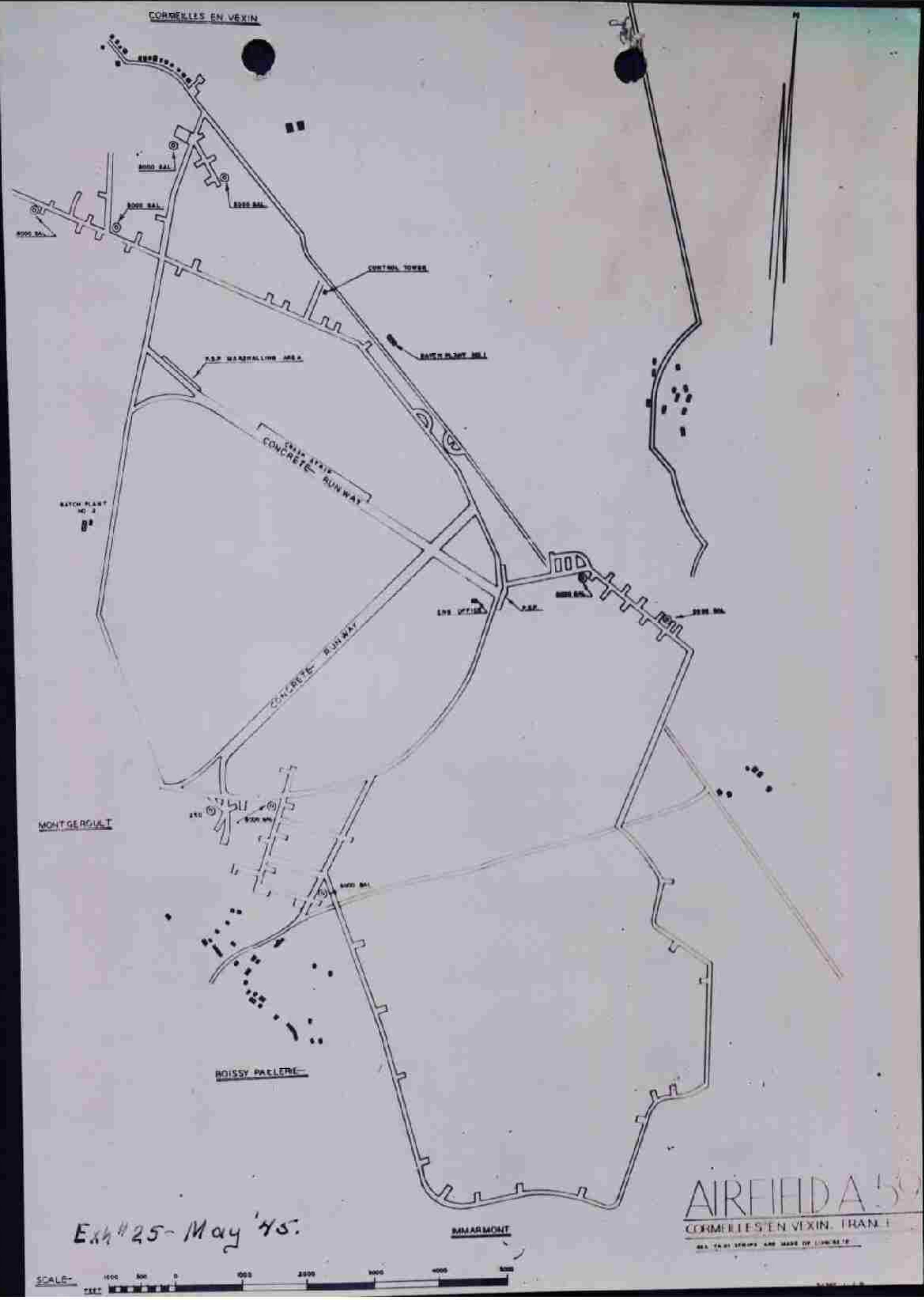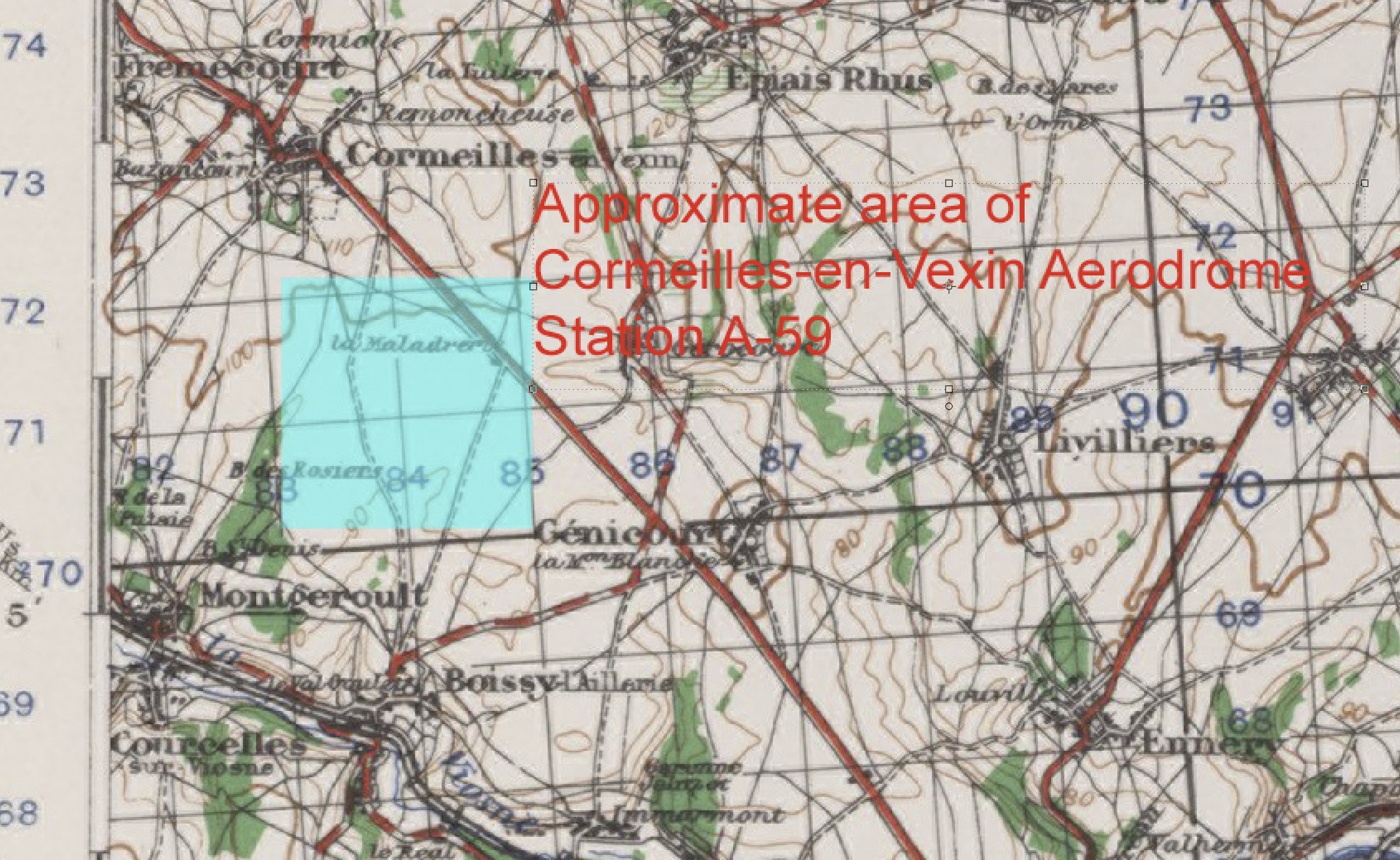 |
416th Bombardment Group (L) Cormeilles-en-Vexin Aerodrome, France Station A-59 25 May 1945 to c. 15 July 1945
|
 |
Return to Table of Contents
 |
416th Bombardment Group (L) Cormeilles-en-Vexin Aerodrome, France Station A-59 25 May 1945 to c. 15 July 1945
|
 |

Cormeilles-en-Vexin map. Exhibit # 25, May, 45 (AFHRA)

Airfield Sketch (AFHRA, Reel=6637 / IRISREF=A5617 / IRISNUM=215629)

Approximate area of Cormeilles-en-Vexin Aerodrome Station A-59
Extracted from GSGS-4336/AMS-M603 Sheet 18 - "Beauvais" 1:100:000 Military Topographic Map
(Downloaded from Perry-Castaneda Library Map Collection - Army Map Service Topographic Map Series,
Belgium, Series 2364, 1:100,000, U.S. Army Map Service, 1937,
Beauvais sheet)
(Annotated Full Map PDF)
Cormeilles-en-Vexin Aerodrome, France - Google Maps 2019
Approximate Latitude/Longitude: 49.10000000,2.03333333 (49° 6' 0" N, 2° 2' 0" E) (Click to view in Google Maps)
Located about 4 miles northwest of Pontoise, France.
Group and Unit Histories
"416th Bombardment Group (L) - Group History 1945"
Transcribed from USAF Archives
May, 1945
While the program was in "full swing", orders were received to move the Group to Station A-59 at Cormeilles-en-Vexin about four miles northwest of Pontoise. On the 19th, an advanced party arrived at the new field. A day later, the 669th and 671st Bomb Squadrons which made up the advance echelon moved by truck convoy to Station A-59. The air echelon arrived on the 24th; the rear echelon, of the 668th and 670th Bomb Squadrons, arrived by motor convoy on the 25th. The move was made with the assistance of two Quartermaster trucking companies. Exh #22.
An inspection of the former base at Laon by the Inspector General of the 9th Air Division found the Station was left in superior condition. Exh #23.
Colonel Aylesworth assumed command of Station A-59 on the 25th. Exh #24. The new base was in far better condition for flying. Exh #25. The NW-SE runway was in excellent condition. The NW-SE runway was being repaired and would soon be available. Although hardstands were crowded, there was sufficient parking space available. The hangers were either partially destroyed or completely destroyed so that they were of little value. Part of this destruction resulted from attacks made by our Group in May 1944 when the field was still in the hands of the enemy.
Group headquarters occupied a chateau in the town of Cormeilles-en-Vexin. Exh #26. Most of the larger Group offices were housed in the chateau. Others were located throughout the town of Cormeilles.
Living conditions for headquarters personnel were a great improvement. Some lived in the chateau; other moved into buildings in the town. The squadrons were less fortunate than heretofore. Because it was thought that our stay on the Continent might be not long, it was felt that transporting tent floors would not be worth the effort. Three of the four squadrons found their living sites in the middle of hay fields. The usual rain, which always seems to plague our moves, turned these areas into mud holes. It was not unusual to see shoes caked with mud ankle high.
"668th Bombardment Squadron (L) History"
Transcription from USAF Archives
May, 1945
After enjoying the "non-ops?" status for several days, and then a complete celebration of VE day, the calm was soon shattered by rumors that we would soon be leaving A-69 for another operational field, when or where the rumors differed, but it was soon established that we would definitely leave, and our destination would be A-59 which was located quite near Paris, which naturally made the personnel quite happy, and perhaps a little impatient to be on our way to our new home.
On the 19th of May the advanced echelon, under the command of Captain JACOBSEN, with eight enlisted men, departed to set up a Squadron Site at A-59. The remainder of the Squadron left the 25th for A-59.
Arriving at our new destination we found that we had a much better field and living conditions were more pleasant than at A-69. All personnel cooperated one hundred percent in setting up our new Site, for all were eager to be one of the first to get a "Paris Pass", for Paris seemed quite near, especially when looking across the field and seeing the Eifel Tower against the sky line.
"669th Bombardment Squadron (L) History"
Transcription from USAF Archives
May, 1945
Before our last combat mission was flown rumors were on the rampage. We were scheduled for a move. Our field must be evacuated. These rumors had a fairly sound backing, but were not taken too seriously because of the frontline situation in Europe. On the 15 May 1945 orders were received to pack. We were scheduled to move to base A-59. Our date to move was set for 24 May 1945. Squadron Headquarters ceased operations at Station A-69 near Laon, France, at 2400 hours on the 24 May 1945. They resumed operations at Station A-59 near Cormeilles en Vexin at 0001 hours on the 25 May 1945.
The advanced echelon was selected. Lt. Van Rope was placed in command and sixteen enlisted men were detailed to accompany him. The advanced echelon left Station A-59 on the morning of the 19 May 1945. They were detailed to lay out the enlisted men's area, set up the messing facilities, and to prepare the Squadron site in general. It was through the efforts of the advanced echelon that the Squadron was able to move into its new home on the 24 May. Seven officers and sixty eight enlisted men proceded to the new field by motor convoy on the 20 May. On the same day two officers and fifty seven enlisted men were flown to the new field. The following day one officer and ten enlisted men proceded to Station A-59 by motor convoy. This unit was the ordnance unit of the Squadron under the command of Lt. Hall. On the 23 May 1945 five officers, two flight officers, and forty five enlisted men were flown to the new base. The following day the air echelon flew into the new station with the airplanes and equipment that was left on the old field. This completed the Squadron's move to Station A-59. All the time this move was in progress the flying training program was functioning without a break in its routine.
In conjunction with the flying training program that was adopted, a ground training program was organized to provide the Squadron personnel with the necessary knowledge for their role in the Pacific war. To add to the confusion of the situation, the Group, as well as the Squadron, was lacking in trained personnel who possessed experience and first hand information of the tactics used in the Pacific Theatre. The lack of such personnel and information concerning the tactics of the new theatre of war left the training program without a scheduled plan. We trained. But no one knew if the training was the necessary training that would be needed in the new Theatre. Conditions of uncertainty prevailed. Orders were issued. Within the same day, or on the following day, the old orders were rescinded, and new orders were issued. Often times these new orders were a direct about face in policy to those orders previously issued. As confusion replaced the usual stability of a well organized combat outfit, the morale obtained through victory in Europe could have been lost had it not been for the abilities of leadership demonstrated by Major Richard Shaefer, our Squadron Commander, combined with the cooperation of the officers and enlisted men of the organization.
The air training schedule, however, never diminished in the number of hours flown. Nor was the flying schedule carried out without its mishaps. On the 16 May 1945 Lt. Martin and Lt. Haskell were both seriously injured when the C-84 in which they were flying crashed on take-off. Lt. Martin was checking Lt. Haskell when the aircraft went out of control and crashed into the old French water wagon that lay at rest on the side of the runway. Lt. Martin suffered third degree burns and Lt. Haskell received a broken jaw-bone. Both men received other slight injuries such as cuts and bruises. The aircraft was completely demolished by fire.
The ground training schedule for all flying personnel was established shortly after V-E day. These classes consisted of aircraft recognition, naval recognition, medical lectures, emergency equipment demonstrations, navigation principles, and physical training. These classes were tied in as near as possible with the flying training program. And wherever it was applicable the information taught in the ground school classes was practiced in the air. After the Squadron moved to Station A-59, ground personnel were sent to school for advanced training. First Lieutenant Andrews, accompanied by T/Sgt Winkle, was sent to a school of technical training at Great Sankey, Lancashire, England. M/Sgt. Dueding and T/Sgts Gettle and Stemler were sent to Britonwood Replacement Depot for further training.
"671st Bomb Squadron (L) Unit History"
Gordon Russell and Jim Kerns
The Period of "Sweat"
With the "Guerre in Europe finit" the men of the 416th Bomb Group at
once went into· a period of sweating it out ... would it be the C.B.I. direct? The
C.B.I. by the way of the United States? Or the army of occup'ation? As redeployment
centers were being set up near to Reims the 416th moved from A-69 to
A-59 at Cormeilles En Vexin, about 25 miles northwest of Paris. The advanced
air echelon flew to the new base on May 20th and by May 25th all but a few of
the personnel were settled at A-59. At this time there was a very strong feeling
that the outfit would go back to the States, probably in July or August. This
wishful thinking was bucked up by the fact that the 416th was the first Group in
the Wing to come overseas.
Meanwhile, in keeping with the policy of the 416th Group, an extensive
training program was scheduled and carried out involving both flight and
ground training. The stress was put on low level formations of various
elements. On the deck buzzing which just a month before was good for a court
martial, was now an S.O.P. As was expected there was a certain amount of
"Chicken" ... reveille each morning at 0615, bedside inspections and a weekly
review.
See Also:
Cormeilles-en-Vexin Airfield, France page at the American Air Museum
Wikipedia Pontoise - Cormeilles Aerodrome page